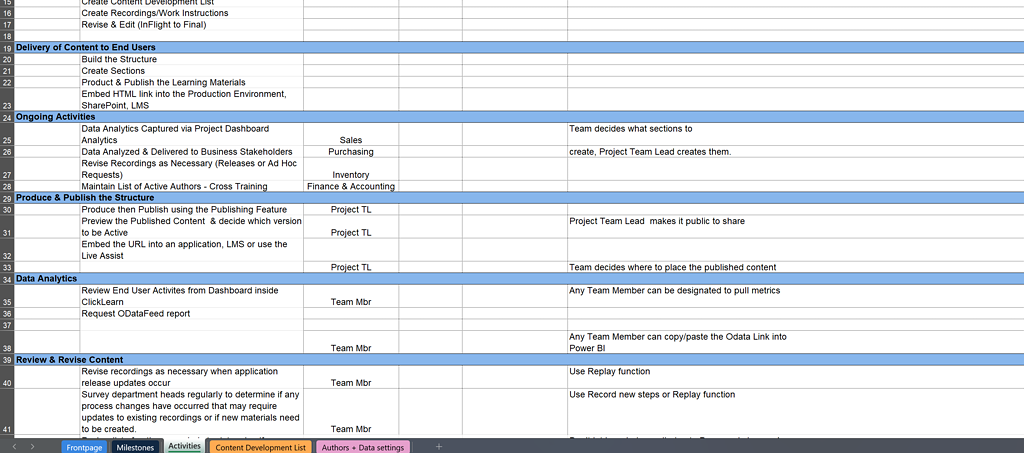Master your Microsoft Dynamics implementation
Free template: Microsoft Dynamics Software Rollout Plan
Ensure a smooth and successful Dynamics 365 implementation with our comprehensive planning template!
Rolling out Microsoft Dynamics software requires thoughtful preparation and coordination — and we’ve simplified the process for you. Download our expertly designed Microsoft Dynamics software rollout template to help you map out key milestones, manage stakeholder communication, and deliver effective user training.

- Expert-designed Oracle template
This template, created by implementation expert Christine Eltz, is built from extensive experience in successful software deployments — including Microsoft Dynamics 365 projects. By using this proven template, you’ll gain insights rooted in best practices for Dynamics 365 rollouts.
- Trusted by professionals
Join countless project managers who have successfully delivered their Microsoft Dynamics software rollout using this strategic planning tool. It’s designed to help you stay organized and aligned throughout every stage of your Dynamics 365 deployment.
- Immediate access
Download the template instantly — no waiting required. Start building your Microsoft Dynamics rollout plan today and take control of your implementation from the start.



Great companies use ClickLearn
Best practices for a smooth Dynamics software rollout
A successful Microsoft Dynamics software rollout plan requires careful preparation and execution. Follow these best practices to ensure a smooth and effective Dynamics 365 implementation:
- Develop a comprehensive rollout plan. Break your Dynamics 365 implementation into clear phases — from pre-launch preparation to post-deployment support. Outline timelines, milestones, and key deliverables to keep your project on track.
- Engage stakeholders early. Involve key decision-makers, IT teams, and end-users from the beginning. Clear communication about goals, timelines, and responsibilities is vital for Dynamics 365 success.
- Prioritize data migration and testing. Thorough testing ensures your Dynamics 365 environment is configured correctly and meets your organization’s requirements. Don’t skip testing critical features like reporting, security roles, and data integration.
- Deliver tailored training for users. Dynamics 365 offers powerful features, but without proper training, adoption can suffer. Provide role-specific training to empower users and increase engagement.
- Monitor performance and gather feedback. Continuously track system performance and gather user feedback to identify any issues or areas for improvement. Regular adjustments ensure your Dynamics 365 implementation aligns with business goals.
The role of feedback in a successful Microsoft Dynamics rollout
Gathering and acting on feedback is essential for ensuring your Microsoft Dynamics 365 implementation meets user needs and drives business outcomes. Incorporating feedback throughout the rollout process helps identify challenges early and ensures your Dynamics environment is optimized for success.
To leverage feedback effectively:
- Create clear communication channels
Establish dedicated spaces for users to share insights, report issues, or suggest improvements — whether through Dynamics 365’s built-in feedback tools, email, or regular team meetings. - Incorporate feedback into development cycles
Use feedback to refine configurations, dashboards, and workflows to improve usability and system efficiency. - Keep stakeholders informed
Regularly update your team on how feedback is being used to enhance the Dynamics 365 experience. This reinforces transparency and shows your commitment to delivering a solution that truly meets business needs.

How to create a Microsoft Dynamics rollout plan
A well-structured rollout plan is key to ensuring a smooth and successful Microsoft Dynamics 365 implementation. Follow these steps to build an effective rollout strategy:
Define clear objectives
Outline what your organization aims to achieve with Dynamics 365. Whether it’s streamlining customer relationship management, improving sales tracking, or enhancing reporting capabilities, clear objectives will guide your plan.Identify key milestones
Break your rollout into manageable phases such as data migration, system configuration, user training, and go-live. Set measurable targets for each phase to track progress and identify potential risks early.Develop a communication strategy
Regular updates are crucial during a Dynamics 365 rollout. Establish clear communication methods to keep stakeholders informed about project timelines, feature changes, and system updates.Prepare for potential roadblocks
Anticipate common Dynamics 365 rollout challenges such as data migration issues, user resistance, or integration errors. Create contingency plans to address these scenarios.Implement feedback loops
Establish ongoing feedback mechanisms to collect insights from end-users. This allows you to continuously refine Dynamics 365 configurations, improve workflows, and ensure maximum user adoption.
Common mistakes in Microsoft Dynamics rollout plans
Even with a solid plan in place, certain pitfalls can hinder the success of your Microsoft Dynamics 365 implementation. Avoid these common mistakes to keep your rollout on track:
Inadequate testing
Overlooking comprehensive testing can result in unexpected issues post-launch. Thoroughly test Dynamics 365 configurations, data migration, and integrations to ensure everything functions as expected before going live.
Poor communication
Failing to keep stakeholders informed can create confusion and resistance. Establish clear communication channels to ensure project updates, timelines, and changes are consistently shared with all relevant teams.
Lack of user training
Dynamics 365 offers powerful features, but without proper training, your team may struggle to adopt them. Provide comprehensive training tailored to different roles to help users gain confidence and maximize the platform’s capabilities.
Ignoring user feedback
Dismissing user feedback can lead to overlooked issues that impact adoption. Actively encourage feedback during testing and after deployment to address concerns and refine system configurations.
Take control of your D365 implementation
Download Dynamics Software Rollout Plan
Gain the upper hand in your next Dynamics 365 deployment! This comprehensive template provides a clear structure for outlining key milestones, planning team activities, and ensuring smooth user adoption.
Don’t leave your implementation to chance — download the template now and stay in control of your Dynamics 365 rollout from start to finish!
Frequently asked questions on Microsoft Dynamics rollout Planning
A Microsoft Dynamics 365 rollout plan is a strategic guide that outlines the steps required to implement Dynamics 365 successfully. It includes timelines, milestones, stakeholder roles, training strategies, and communication methods to ensure a smooth deployment.
Dynamics 365 is a powerful yet complex platform. A well-structured rollout plan minimizes risks, prevents disruptions, and helps your team adopt the system effectively. It also ensures data migration, integrations, and user training are managed efficiently.
To improve adoption, focus on early stakeholder engagement, clear communication, and comprehensive user training. Providing hands-on practice sessions and encouraging feedback during the rollout phase also enhances adoption rates.
Some common challenges include data migration issues, user resistance, and insufficient training. To overcome these, invest in thorough testing, provide ongoing support, and address user concerns proactively.
The timeline varies based on your organization’s size, complexity, and existing systems. Smaller projects may take a few weeks, while larger enterprise-level implementations can span several months.


